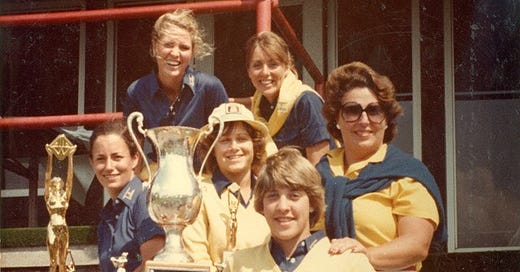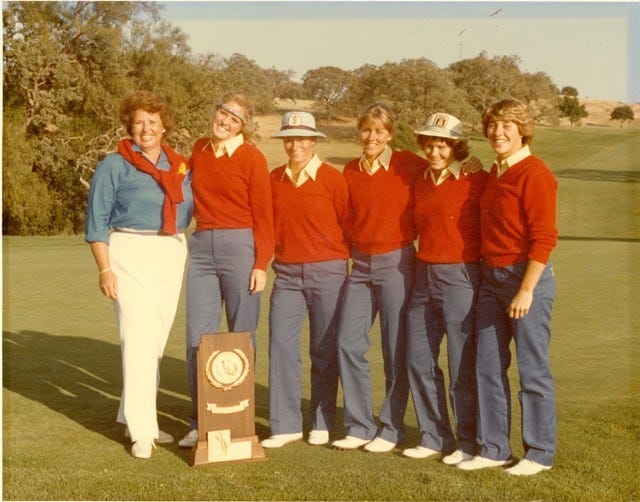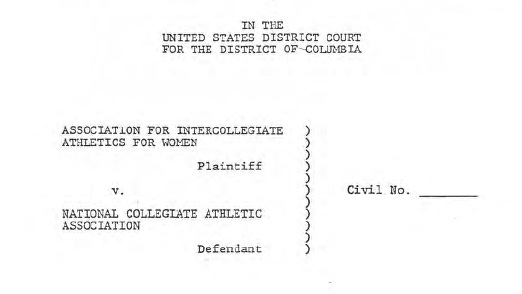Women's Championship Series #10: 1982
The Golden Hurricane that Spanned Across the AIAW and NCAA
This is part of a series on the Women’s Collegiate Championships
Our series, much like women’s collegiate athletics in general, comes to an interesting crossroads when talking about the 1981-82 season. Some 40+ years removed from these events, it’s hard to look back on this moment without treating the changeover from the AIAW to the NCAA’s governance of women’s intercollegiate sports as anything but inevitable when in fact the opposite seemed true at the time. In the previous 75 years of its existence, the NCAA had done nearly everything it could to stay removed from women’s athletics, both for their own self-interest and at the request of the women’s organizations that developed over time. Everything changed after a vote to add women’s sports narrowly passed in 1981.
With everything going happening off the course, it’s easy to lose sight of Tulsa’s incredible accomplishments in 1982, winning both the last AIAW and first NCAA golf championships. And here is where our tournament count gets off: by the end of 1982 had there been 1 or 39 women’s collegiate golf championships played?
*NOTE 1: underlined text provides a link to references or sites with more information
*NOTE 2: we have done our best to cull out sources that contain problematic language or sentiments, but sometimes those things cannot be helped or are otherwise included to illustrate a point; we hope you understand this usage and recognize its educational purpose is not an endorsement
AIAW vs NCAA
The National Collegiate Athletic Association (NCAA) was created in 1906 as a national membership organization to govern male intercollegiate sports among 4-year universities/colleges across the United States. As we’ve covered in this series, there was a long and arduous path leading to the rise of national women’s organizations such as the Division for Girls’ and Women’s Sports (DGWS), and all along the way the NCAA served indirectly as a blueprint for how women’s athletics policies were shaped.
RELATIONSHIP IN THE 1960s
In order to handle the national organization of extramural athletic competitions for women’s collegiate teams, the DGWS created the Commission on Intercollegiate Athletics for Women (CIAW) in 1966. At times, CIAW officials sought guidance from the NCAA, establishing a more direct relationship between the overseers of men’s and women’s college sports. In fact, there were multiple occasions where members of each association’s executive committee (first the DGWS then later the CIAW) attended the other’s official meetings, occasionally providing input on rules and policies changes. One of those changes was the NCAA prohibiting women from competing on men’s teams - such as Tennessee’s __ in 1964-65 - at the direct request of the DGWS. Throughout this time, the NCAA made clear in no uncertain terms that they were not venturing into women’s collegiate athletics.
TITLE IX CHANGES THINGS IN THE 1970s
The 1970s brought great, and in some ways terrible, change. The CIAW gave way to the Association of Intercollegiate Athletics for Women (AIAW) at the very beginning of the decade and around the same time Congress passed Title IX of the Education Amendments of 1972. While the NCAA and AIAW were not yet contentious, even two years after its passing, it is clear that Title IX was a major concern. As most things do, it essentially boiled down to money, with the NCAA expressing consternation over the application of “equal versus equitable” funding for women’s athletics and how that might affect their main products, aka: revenue-generating sports. To be fair, even the AIAW was concerned with these details, with President Carol Gordon stating in 19741
We recognize that societal expectations from men's athletics create some special problems to be solved, but these problems should not cause us to negate the concept of a non-discriminatory approach in providing opportunities for both men and women athletes. AIAW has been quoted as insisting on equal funding for men's and women's programs. As an organization, our total stress has been on equality of opportunity for participation in quality programs and not on equal funding.
Our organization is not naïve regarding the tremendous problem that revenue producing sports create, but neither are we naïve about the problems that women's programs have faced and are facing on many campuses. We implore you to remain firm in support of equal opportunities for women which we fear may well be lost even as responsible people work to clarify interpretations of the Guidelines. We hope that all concerned can work to change certain sections that create problems for all athletic programs. However, it would be tragic if pressure is generated which will negate the opportunity to end discriminatory practices.
Within a few years, all attempts at working together towards a unified solution effectively ceased. In her later affidavit, the late-1970s AIAW President Donna Lopiano summed up the situation as follows:
Throughout 1977, the NCAA pursued its two-pronged assault on women’s intercollegiate athletics: to dilute or eradicate Title IX’s coverage of intercollegiate athletics; and to expand into women’s athletics. In my judgement, either of these efforts would have been materially altered by the success of the other: the NCAA would have been far less interested in undermining Title IX had it controlled women’s intercollegiate athletics and far less eager to control women’s athletics had it successfully truncated Title IX coverage."
The truth was that the two organizations had vastly different rules to match their vastly different outlook on collegiate athletics, which did not blend well. This meant changing (or compromising, depending on your level of cynicism) at a base level, which was much easier to do when you had money in the coffers and not just promissory notes earmarked for education; ironically, scholarships were the one area where the AIAW had the advantage over the NCAA.
THE ROAD TO TWO CHAMPIONSHIPS (1980s)
With the close of the 1970s also came the official close to the revision period the US Department of Health, Education, and Welfare (HEW) had allowed to work with the NCAA and AIAW before bringing the full effects of Title IX into practice. Almost immediately, after years of stating they were not interested in carrying women’s intercollegiate athletics, NCAA delegates called for an official vote on the matter of hosting some women’s championships. The first vote came in January 1980 when two resolutions came before the annual NCAA convention to sponsor a total of 5 women’s sports championships across DII and DIII (basketball, field hockey, swimming, tennis, and volleyball). A year later, the death knell for the AIAW was struck with the NCAA vote to add 12 DI women’s sports, including golf.
Emotions ranging from contemplative curiosity to outright anger played across headlines in newspapers throughout the United States, and yet the reader can all but see the author in each case shrugging with a resigned “Well what can you do?” It seemed, if not inevitable, then at the very least unsurprising that the organization that had positioned themselves as the authority on collegiate sports would take on the magnanimous burden of shepherding women’s sports into the “big time.” Nevermind that they had legally fought it. Nevermind that they had practically shouted that they were fine with the status quo prior to having their hands forced. Nevermind that the players, programs, and/or schools didn’t necessarily want it. The truth was that, once set in motion, this seemed like the only way things would go, and what was possibly worse was the undeniable truth that there were unquestionably good benefits in the move to a more well-funded organization that was already talking the future of televised women’s sports. Nevermind that it might truthfully be for the better in the long run, to some - perhaps most - it felt...unfair and unjust. And yet, there were opportunities on the horizon.
THE FIRST NCAA TOURNAMENT [May 26-29, 1982]
Stanford played host to the first NCAA women’s golf championship, and players could not have asked for a better venue to begin the next chapter of college golf history. This history is what some teams had on their mind, knowing that appending “Winner of the 1st NCAA Golf Championship” to their name would leave an indelible mark. Some felt differently. Although there was significant overlap expected between this championship and the AIAW tournament the next month, some disputed the NCAA’s tournament and chose not to participate. Even still, the competition present at Stanford for the 1st (or is it 38th?) championship was fierce.
TEAM RESULTS
Tulsa drew the late-early tee time for the first two days, getting the dry wind in the afternoon of the first day, and cold wind the morning of the second round. Feeling right at home in these conditions, the Golden Hurricanes opened up a 20 shot lead with a 294-298=592 total compared to Florida’s 612. That lead stretched to 30 strokes by the end of the third round. Even before the first shot was struck in the final round that Saturday afternoon, the tournament was practically decided from a team standpoint. That afternoon, Coach McNamara’s Tulsa squad lifted the new NCAA championship trophy, a near identical wooden twin of the one awarded to the men. All that was left was to crown an individual champion.
INDIVIDUAL RESULTS
The individual title race was not as straightforward as the team championship, but in the end it was still hurricane season. Kathy Baker was able to fend off a number of highly-regarded competitors such as San Jose State legend Juli Inkster, the two-time defending US Women’s Amateur champ who would soon make that three consecutive titles. Finishing just a shot behind Baker was Tulsa teammate Jody Rosenthal who earned 1st Team All-American honors that year and would go on to become the first player at Tulsa to earn four such distinctions. Rounding out the 1-2-3 Tulsa punch was Barb Thomas who earned her own All-American Honorable Mention for her play in 1982. Kathy Baker became the first Tulsa player to win an NCAA title in any sport, and together with her teammates, earned the university its first NCAA team title.
THE LAST AIAW TOURNAMENT [June 16-19, 1982]
In a way, it’s fitting that the final AIAW golf tournament was hosted by Ohio State and that golf was one of the final championships the organization sponsored. A certain subset of the teams that met at Stanford for the NCAA championship met again less than a month later at Ohio State. They were joined by additional nationally competitive teams, all vying for the 38th (or was it now 39th??) women’s golf championship. In any case, 41 years later, competitive women’s college golf returned to the place where it could be said to have really begun, at OSU’s historic Scarlet Course.
INDIVIDUAL RESULTS
Tulsa’s Kathy Baker, looking to secure her second golf championship title in a month, hit a speedbump with a third round 79 that proved too big of a momentum-killer to catch back up. SMU sophomore Amy Benz raced away from the field with a final round 73 to take the title by 6 strokes over Georgia’s Cindy Pleger. Benz became the second Mustang individual champion in 4 years, following in the footsteps of the great Kyle O’Brien. Both women had been coached by SMU great Earl Stewart who himself had made college golf history as a player back before WWII while at LSU.
A month later, Amy Benz joined forces with Kathy Baker and Juli Inkster to represent the US at the World Amateur Team Championship (aka: Espirito Santo Trophy). This time it was Inkster taking the individual crown as the team took home the gold. Soon after, all three again represented the US in the 50th anniversary Curtis Cup match, taking a historic 14.5-3.5 victory over GB&I.

TEAM RESULTS
Unlike at the NCAA tournament, Tulsa didn’t get the consistently great rounds from a couple of their top players, and instead had to rely on teammates picking each other up as they traded off rounds with blow-up scores. A great sub-300 second round put them out front, but then were passed by others with even better third rounds. Back-to-back low scores put Florida in the driver seat entering the final round, holding a slim lead over Tulsa and Texas despite their disastrous first round. A combo of difficult pin placements, heavy winds, and intermittent cold rain made for perfect Hurricane conditions as the competition slowly fell away over the course of the final 18 holes. In the end, Tulsa was able to coast into the clubhouse where they became the final recipients of the Colgate Cup.
“I think this is as complete a golf team as you’re ever going to find,” said McNamara. “It’s been a very consistent, very complete golf team; they used their heads in every sense of the word. I’m just so thrilled to have been able to touch the lives of these girls. They had all the pressure in the world on them. Now, they are a part of history.” - Tulsa World, Jun 20 1982

In recognition of their historic accomplishments, the 1981-82 team as a whole was inducted in to the Tulsa Athletic Hall of Fame in 1991. The university put together a fantastic video tribute on the 40th anniversary of the tournament that you can watch here
AFTERWARDS
Notionally it seemed there would be some time for the AIAW to figure things out as schools/programs could belong to both collegiate organizations (up to 1985), but the reality was that the decision was already made. The NCAA had a huge leg up on the AIAW in the form of looser recruiting restrictions, allowance for the school to pay for travel expenses for recruits and current players, and even reimbursement of nearly all expenses incurred participating in the national championships. Add in the fact that schools would be committing to paying dues for two organizations, and there wasn’t really much of a choice. As their membership dwindled and on the brink of needing to cease operations entirely, the AIAW turned to the courts.
THE LAST LEGAL GASP
Although the entire legal case is fascinating (and possibly worth a future post breaking it down further), this post has already gone on for too long, so here are some of the key arguments the AIAW hung it’s case on:
The NCAA’s history suggested that they only considered women’s sports as far as needing legal cover (not exclusively limited to Title IX)
The NCAA used their substantial monetary power (despite being a non-profit organization) in anti-competitive ways such as not increasing dues (for a limited time) for members who wanted to add their women’s programs, and other financial enticements to whittle away AIAW membership, and by extension funds
The NCAA’s actions in their negotiations with respect to their television contracts negatively impacted the AIAW’s own contracts with NBC and ESPN to the point where both networks failed to give any television exposure to any AIAW championship in 1981-82
The NCAA essentially forced through the vote to add women’s sports with “…an abuse of its parliamentary processes at the 1981 Convention in forcing the governance plan through on the vote of a bare majority intimidated by fear of disciplinary sanctions.”
The NCAA boasted 208 appointments for women but this fell woefully short of the 1296 positions lost with the AIAW folding
In the end, the judgement came down in favor of the NCAA, citing essentially that the AIAW failed to prove that:
the NCAA was acting with the “…conspiratorial plotting of a would-be monopolist…”
“While the evidence of parliamentary maneuvering may evince the leadership’s determination to see the proposal for women’s governance adopted, it does not prove that such determination derived from an intent to monopolize.”
the “…so-called ‘irresistible inducements’ tendered by the NCAA” were anything other than “altogether illusory”
the NCAA “…in effect, bought defectors from the AIAW with its superior economic resources.”
After this ruling February 28, 1983, the AIAW met one final time and effectively disbanded in June of that year.
TITLE IX APPLYING TO ATHLETICS (OR NOT)
Interestingly, the Supreme Court decision in the Grove City v. Bell case in February 1984 ruled that Title IX did not necessarily apply to athletic departments, effectively limiting coverage for athletics to just the issue of athletic scholarships. This seems like a win too late for the AIAW to enjoy, however it was eventually reversed in early 1988 with the passage (over the veto of President Reagan) of The Civil Rights Restoration Act of 1987 which clarified that “if any program or activity in an educational institution receives federal funds, all of the institution’s programs and activities must comply with Title IX.” Even if the AIAW still existed at this point, it’s doubtful that the NCAA would have dropped women’s athletics in the brief time between those two rulings, and thus the AIAW would still be in the same tough spot.
Going forward from the 1980s, women’s collegiate golf, for better or worse, would fall under the guidance of the monolith (some still argue “monopoly”) of the NCAA.
Thanks for reading!
Up Next:
In the next post for this series, we will cover the stolen championship of 1988.
Hunt, Virginia. Governance of Women’s Intercollegiate Athletics: An Historical Perspective. Dissertation for a doctorate degree of education from the University of North Carolina at Greensboro. 1976.


















